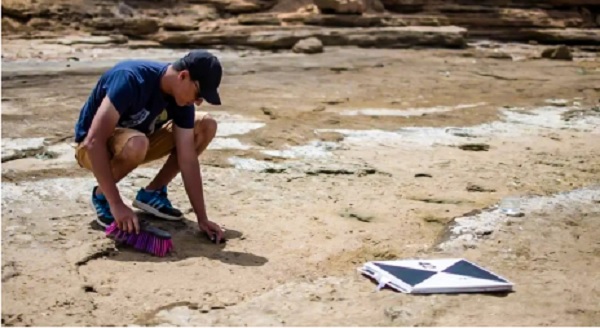
SPECIAL REPORT | BIRD AGENCY | A group of international researchers stumbled upon well-preserved early human footprints on a Moroccan beach, which is among the oldest in the world. Their recently published research offers a deeper look into the discovery, reports Kate Okorie
In July 2022, an international team of researchers on a field trip to study boulders along a rocky coastline in the city of Larache, northwest Morocco, made an unexpected discovery on the shores of a nearby beach.
They found well-preserved footprints spanning an area of 2,800 m² on the rocky shores of the beach. Their research, published on January 23, determined that these footprints belonged to a multigenerational group of Homo sapiens who walked along the beach about 90,000 years ago.
The Larache footprint is the oldest known Homo sapiens footprint in North Africa and ranks among the world’s oldest as well.
Upon discovering the trackway on the indurated shore, the team, which included specialists in geomorphology and the dynamics of coastal environments, recognised the impressions as ancient footprints. However, to verify their observations, they sought the help of other specialists.
“We immediately contacted renowned specialists in paleoanthropology who confirmed that these were indeed hominin footprints,” Abdelmounim El M’rini, a member of the research team and a professor in the Department of Geology at the Abdelmalek Essaadi University in Morocco, told bird story agency via email.
He shared that the team on the ground in Larache rallied to analyse the footprint’s physiological characteristics.
“We conducted drone surveys and took photographs (of the footprints) from different angles. In addition, we tried to identify indicators of the paleoenvironment where these footprints were initially made,” he said.
To support their geological investigation, they used optically stimulated luminescence dating a technique that measures the last time mineral grains were exposed to light or heat to estimate the age of the footprint site.
The footprints, which date back over 90,000 years to the late Pleistocene epoch, also known as the last ice age, were most likely left by at least five ancient humans, including young children, adolescents, and adults.
Previous research highlights the critical role of Morocco’s coastal areas in providing access to resources, suggesting that these individuals were likely in pursuit of marine resources.
El M’rini noted that although they found nearly 200 footprints on the rocky shores of the beach, they selected 85 for the research.
“We have only examined the best-preserved 85 footprints. Dozens more human and potentially animal prints remain to be explored and studied,” said Mouncef Sedrati, the study’s lead author and a life sciences professor at France’s University of South Brittany, in a Forbes interview.
Footprints serve as evidence of life, providing direct insights into the biological characteristics, movement patterns, and lifestyle habits of early humans.
In the last two decades, the number of human footprint sites discovered worldwide has increased, although they are unevenly distributed.
In Africa, the majority of trackways related to ancient humans and their close relatives have been identified in East Africa (five sites) and Southern Africa (nine sites). Despite North Africa’s importance in the study of human evolution, footprint sightings have been relatively rare.
Since the 1976 discovery of human footprints at Laetoli in northern Tanzania, paleoanthropologists have stressed the significance of studying them. The Laetoli footprints, dating back 3.66 million years, are the earliest direct evidence of bipedal humans, although they do not belong to the Homo sapiens species. This finding supports the hypothesis that significant evolutionary changes in human gait occurred over the last 3.66 million years.
Apart from the findings in Larache, only two other regions in the world have recorded older Homo sapiens footprints. One such region is South Africa, which is the location of the oldest recorded Homo sapiens footprint site, dating back 153,000 years.
“This kind of discovery aids in refining periods and understanding the temporal aspects of human migration and settlement,” said Bolaji Owoseni, a postdoctoral fellow at the McDonald Institute for Archaeological Research, University of Cambridge. She was not a member of the research team.
“Understanding where and when humans moved across regions is vital for constructing narratives of population movements and interactions,” said Owoseni.
However, some of these footprint sites are at risk of being lost to coastal erosion, compelling scientists to quickly document and analyse them.
Even though the rocky shore platform where the Larache footprints were found is elevated and shielded by a boulder, they remain vulnerable to destruction from rising sea levels and storms.
However, environmental factors are not the only threat to archaeological sites in Africa.
“Beyond climate change, archaeological sites in Africa face a multitude of threats, including illegal excavation, war and conflict, unregulated tourism, natural disasters, vegetation overgrowth, environmental pollution, and inadequate legislation and enforcement,” Owoseni explained.
She also emphasised the critical role of collaborative efforts between scientists, local communities, governmental bodies, and international organisations in ensuring the long-term preservation of important archaeological sites like the Larache footprints location.
While El M’rini and his colleagues are uncertain about how long the Larache footprints will remain intact, they are intrigued by the possibility of more trackways being revealed over time, which would further enrich their research findings.
“Under hydrodynamic conditions and in the context of sea level rise, these footprints would be subject to erosion, but with the retreat of the cliffs, other footprints would be revealed,” he explained.
*****
Source: Kate Okorie bird story agency
 The Independent Uganda: You get the Truth we Pay the Price
The Independent Uganda: You get the Truth we Pay the Price


